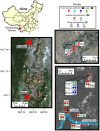A comprehensive census of microbial diversity in hot springs of Tengchong, Yunnan Province China using 16S rRNA gene pyrosequencing
- PMID: 23326417
- PMCID: PMC3541193
- DOI: 10.1371/journal.pone.0053350
A comprehensive census of microbial diversity in hot springs of Tengchong, Yunnan Province China using 16S rRNA gene pyrosequencing
Abstract
The Rehai and Ruidian geothermal fields, located in Tengchong County, Yunnan Province, China, host a variety of geochemically distinct hot springs. In this study, we report a comprehensive, cultivation-independent census of microbial communities in 37 samples collected from these geothermal fields, encompassing sites ranging in temperature from 55.1 to 93.6°C, in pH from 2.5 to 9.4, and in mineralogy from silicates in Rehai to carbonates in Ruidian. Richness was low in all samples, with 21-123 species-level OTUs detected. The bacterial phylum Aquificae or archaeal phylum Crenarchaeota were dominant in Rehai samples, yet the dominant taxa within those phyla depended on temperature, pH, and geochemistry. Rehai springs with low pH (2.5-2.6), high temperature (85.1-89.1°C), and high sulfur contents favored the crenarchaeal order Sulfolobales, whereas those with low pH (2.6-4.8) and cooler temperature (55.1-64.5°C) favored the Aquificae genus Hydrogenobaculum. Rehai springs with neutral-alkaline pH (7.2-9.4) and high temperature (>80°C) with high concentrations of silica and salt ions (Na, K, and Cl) favored the Aquificae genus Hydrogenobacter and crenarchaeal orders Desulfurococcales and Thermoproteales. Desulfurococcales and Thermoproteales became predominant in springs with pH much higher than the optimum and even the maximum pH known for these orders. Ruidian water samples harbored a single Aquificae genus Hydrogenobacter, whereas microbial communities in Ruidian sediment samples were more diverse at the phylum level and distinctly different from those in Rehai and Ruidian water samples, with a higher abundance of uncultivated lineages, close relatives of the ammonia-oxidizing archaeon "Candidatus Nitrosocaldus yellowstonii", and candidate division O1aA90 and OP1. These differences between Ruidian sediments and Rehai samples were likely caused by temperature, pH, and sediment mineralogy. The results of this study significantly expand the current understanding of the microbiology in Tengchong hot springs and provide a basis for comparison with other geothermal systems around the world.
Conflict of interest statement
Figures



Similar articles
-
Bacterial and archaeal diversities in Yunnan and Tibetan hot springs, China.Environ Microbiol. 2013 Apr;15(4):1160-75. doi: 10.1111/1462-2920.12025. Epub 2012 Nov 6. Environ Microbiol. 2013. PMID: 23126508
-
Diversity of Culturable Thermophilic Actinobacteria in Hot Springs in Tengchong, China and Studies of their Biosynthetic Gene Profiles.Microb Ecol. 2016 Jul;72(1):150-162. doi: 10.1007/s00248-016-0756-2. Epub 2016 Apr 5. Microb Ecol. 2016. PMID: 27048448
-
Distribution of ether lipids and composition of the archaeal community in terrestrial geothermal springs: impact of environmental variables.Environ Microbiol. 2015 May;17(5):1600-14. doi: 10.1111/1462-2920.12595. Epub 2014 Oct 13. Environ Microbiol. 2015. PMID: 25142282
-
Microbial Diversity of Terrestrial Geothermal Springs in Armenia and Nagorno-Karabakh: A Review.Microorganisms. 2021 Jul 9;9(7):1473. doi: 10.3390/microorganisms9071473. Microorganisms. 2021. PMID: 34361908 Free PMC article. Review.
-
Microbes in mercury-enriched geothermal springs in western North America.Sci Total Environ. 2016 Nov 1;569-570:321-331. doi: 10.1016/j.scitotenv.2016.06.080. Epub 2016 Jun 24. Sci Total Environ. 2016. PMID: 27344121 Review.
Cited by
-
Isolation of diverse members of the Aquificales from geothermal springs in Tengchong, China.Front Microbiol. 2015 Feb 27;6:157. doi: 10.3389/fmicb.2015.00157. eCollection 2015. Front Microbiol. 2015. PMID: 25774153 Free PMC article.
-
Covariation of hot spring geochemistry with microbial genomic diversity, function, and evolution.Nat Commun. 2024 Aug 29;15(1):7506. doi: 10.1038/s41467-024-51841-5. Nat Commun. 2024. PMID: 39209850 Free PMC article.
-
Diurnal Changes in Active Carbon and Nitrogen Pathways Along the Temperature Gradient in Porcelana Hot Spring Microbial Mat.Front Microbiol. 2018 Oct 2;9:2353. doi: 10.3389/fmicb.2018.02353. eCollection 2018. Front Microbiol. 2018. PMID: 30333812 Free PMC article.
-
Impacts of temperature and pH on the distribution of archaeal lipids in Yunnan hot springs, China.Front Microbiol. 2013 Oct 30;4:312. doi: 10.3389/fmicb.2013.00312. eCollection 2013. Front Microbiol. 2013. PMID: 24194734 Free PMC article.
-
Metabolic versatility of small archaea Micrarchaeota and Parvarchaeota.ISME J. 2018 Mar;12(3):756-775. doi: 10.1038/s41396-017-0002-z. Epub 2017 Dec 8. ISME J. 2018. PMID: 29222443 Free PMC article.
References
-
- Liao Z, Guo G (1986) Geology of the Tengchong geothermal field and surrounding area, west Yunnan, China. Geothermics 15: 339–345.
-
- Tong W, Zhang M (1989) Tengchong geothermics. Beijing: Science Press (in Chinese). 282 p.
-
- Wang F, Peng Z, Chen W, Wang Z, Yang J, et al. (2000) High-precision thermal ionization mass spectrometry dating of young volcanic rocks by using U-series method. Chinese Sci Bull 45: 83–87.
-
- Du J, Liu C, Fu B, Ninomiya Y, Zhang Y, et al. (2005) Variations of geothermometry and chemical-isotopic compositions of hot spring fluids in the Rehai geothermal field, southwestern China. J Volcanol Geoth Res 142: 243–261.
-
- Fournier RO (1989) Geochemistry and dynamics of the Yellowstone National Park hydrothermal system. Annu Rev Earth Planet Sci 17: 13–53.
Publication types
MeSH terms
Substances
LinkOut - more resources
Full Text Sources
Other Literature Sources

